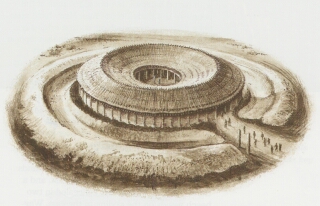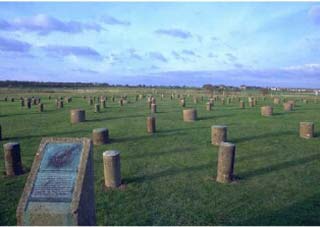 |
Woodhenge reconstructed - it is also possible that there was no roof |
Woodhenge is a Late Neolithic or Early Bronze Age monument originally made up of a series of concentric circles of wooden poles within a circular bank and ditch. It is of similar size to Stonehenge and lies between Larkhill and Amesbury, about 2km (1.2miles) north east of the stone circle.
This site was first discovered in 1925 when rings of dark spots in a crop of wheat were noticed on aerial photographs. Excavation of the site then showed that the dark spots were holes for wooden posts.
Woodhenge - The Origins of the Site
The site originally consisted of 6 rings of wooden posts radiating out from a central point. They were enclosed within an earthen bank and ditch with a north east entrance as at Stonehenge.
It has conventionally been dated to about 2300-2000BC, making it contemporary with the building of the stone circle of Stonehenge. But excavations in the 1970s using new radio carbon dating techniques suggested that it could be more recent.
Woodhenge - A Mystery Uncovered
 |
Woodhenge reconstructed - it is also possible that there was no roof |
Excavations during the 1970s at Woodhenge revealed that a child had been buried near to the centre of the enclosure. The skull of the child had been split.
Was this for a religious or ritual reason? Early prehistory monuments often include human remains. These are thought to be sacrifices or offerings to mark the beginning of its use.
Grid reference SU 151 434.
360° View
The Interactive Stonehenge Web Map offers you the chance to view panoramic photos of many monuments. Stonehenge Interactive Map
Visit Wiltshire Links
Woodhenge
Burial Mounds
The Avenue
Normanton Down
Avebury Stone Circle
Silbury Hill
Chalk Hill Figures
West Kennet Long Barrow
Crop Circles
Old Sarum Hillfort
Salisbury City and Cathedral
|